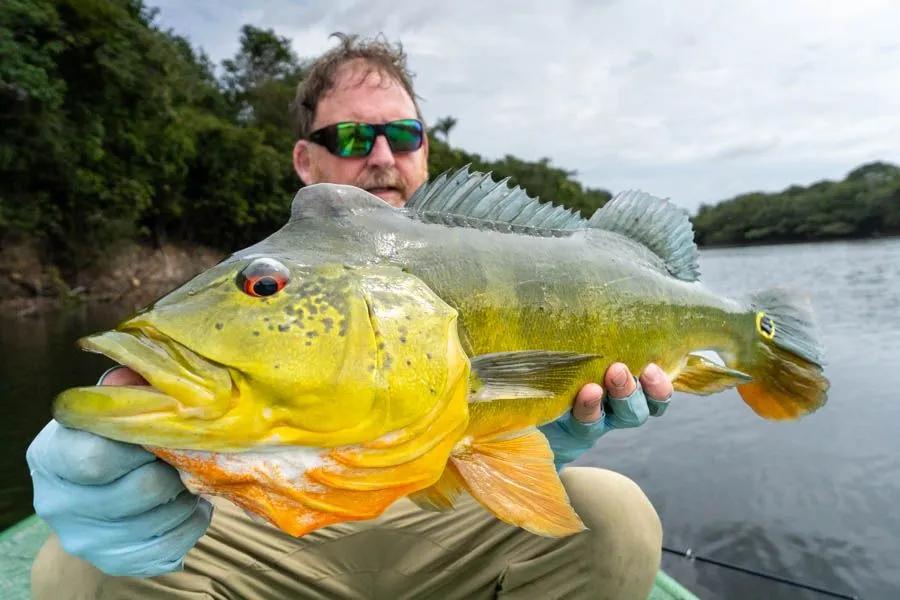
Arapaima, peacock bass, piranha, arowana, redtail catfish, flounder and oscars…oh my! This is a short list of some of the many varieties of species landed on our most recent trip to Agua Boa Lodge in Brazil. A trip to the jungle is also more about the fishing, and the wildlife viewing proved equally impressive. We encountered capybara, white-faced capuchin monkeys, giant river otters, macaws, toucans, cayman, howler monkeys, tapirs, pink dolphins, a manatee and so much more. The opportunity to chase exotic jungle species on a fly rod coupled with world class wildlife viewing certainly helps to launch this experience into the "trip of a lifetime" level of awesomeness.
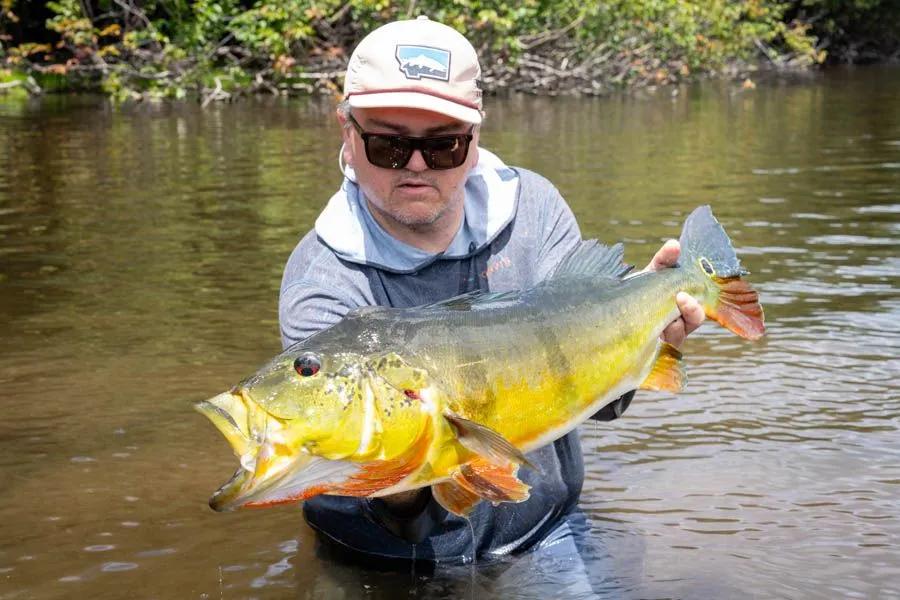
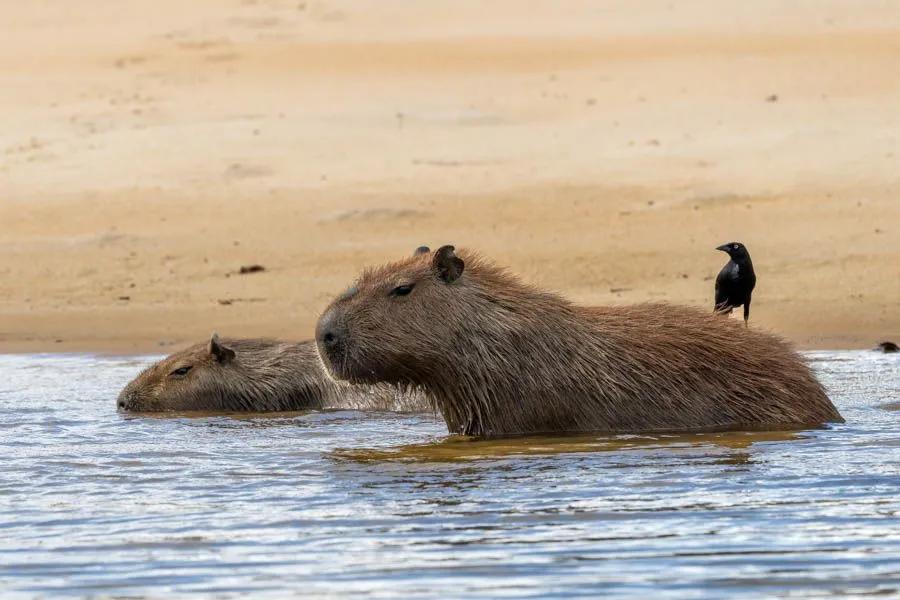

Brazil’s Agua Boa Amazon Lodge is perched above the Agua Boa River. It lies in the northeast corner of the massive Amazon jungle, hours away by boat or plane from the nearest town. The Agua Boa River is one of over 1,000 tributaries to the Amazon River and is a clear water river, which lends itself to some great sight fishing opportunities. The lodge is surrounded by a protected part of the jungle and the section of river that is fished from the lodge is the only fly fishing only section of river in Brazil. There is a single, barbless hook policy in place as well. The river averaged about 100 yards wide and was relatively shallow in most places with a sandy bottom. The biggest fish of the trip was an arapaima that weighed over 50lbs and was landed even after the 9 weight rod broke mid fight. We had 14 total anglers, and the group landed well over 1,000 fish over the course of the week, with our biggest peacock bass weighing in at 17lbs. Over the course of the season several lucky lodge guests will likely tangle with a few 20lb plus monsters.
The fishing season takes place during the region's dry season, so the river was near its lowest level of the year when we visited. River levels can fluctuate significantly between the wet and dry season. The water can be 20 or more feet higher than the levels we experienced during the rainy season. The lower flows coupled with relatively clear water made for great sight casting conditions. Fish were easier to spook in these conditions however, so gear selection and technique were important. This was my first trip to the Agua Boa system, but our past Montana Angler hosts have described great fishing at higher water levels on prior trips too. Each level of the river has its advantages, with lower flows providing very visual fishing but spookier fish, and higher flows providing less wary fish and even more access to the lagoon systems.
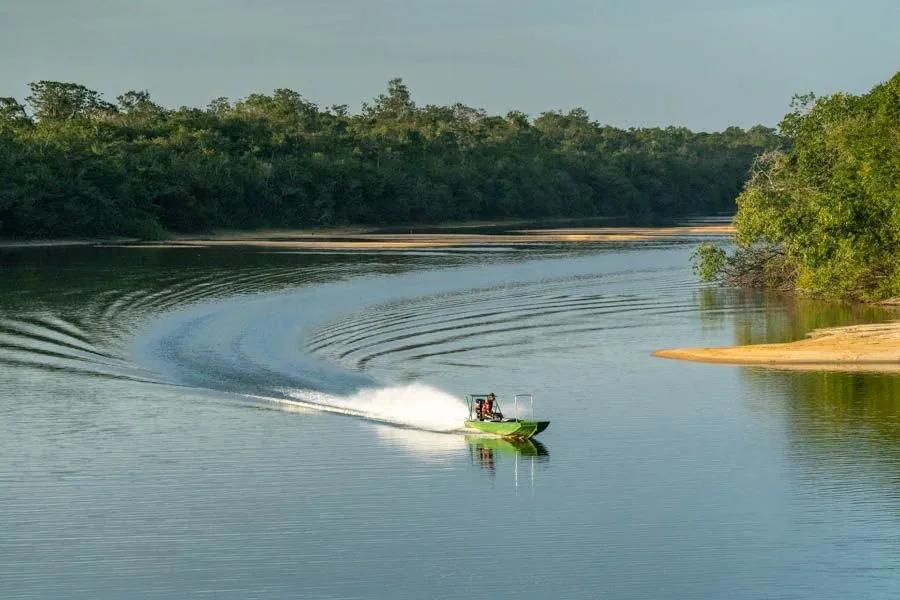
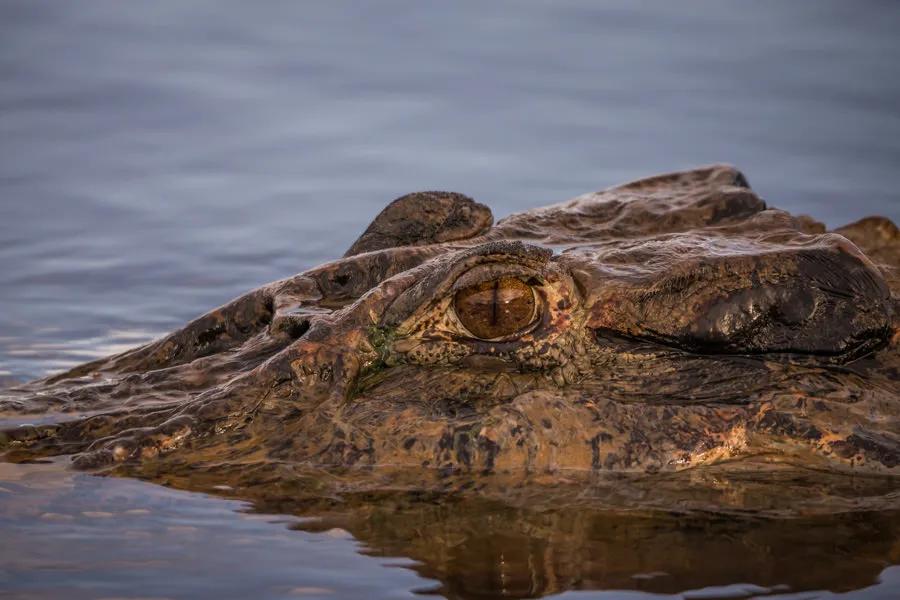


Mornings at the lodge began early with a breakfast buffet and a hot pot of coffee ready to go. In the dining room the crew also sets up a lunch buffet where you make your own lunch with a variety of ingredients, which is typically sandwich stuff, fruit, and a variety of cookies. Many of us enjoyed making our own, custom sandwiches. When done, of the staff wraps your lunch up in waterproof containers and you are responsible for delivering the lunch to your guide. After packing up lunches it is time to head out to the docks. The guides are rotated each day based on your cabana number. Each guide has their own beat that they fish every day. Within each beat there is typically a long, 10-15 mile section river, as well as numerous lagunas that are often also utilized. The guides tend to rest different lagunas and river sections in their beat so the fish are always fresh. After jumping in with your assigned guide for the day, they will motor you to their beat. Some beats are a short 15 minute ride from the lodge. The furthest beats from the lodge can take up to an hour to get to by boat and are as far as 40-50 miles up or down the river. These longer trips are a spectacular opportunity to soak in the natural beauty of the National Preserves and National Park and the pristine wildlife that the forests hold. After fishing wraps up each day it is time to grab your camera again, turn the hat backwards, and go into river "safari" mode for the ride back.
As much as I love to fish, a big highlight for me was spending almost an hour with a couple of capybaras that were hanging out along the bank of the river on day where we ate lunch. Capybaras are the largest living rodent and one of the cutest darn animals you’ve ever seen, and this pair allowed us to get within about a fly rod length of them. Some of my fondest memories from the trip will be the sounds of the jungle coupled with the soothing sounds of the guide poling around a lagoon. There were times when you could hear howler monkeys in the distance along with dozens of different birds singing their songs. My boat partner Clark made a point to record as many of these sounds so that he could take home and create his own jungle soundtrack. Cayman can be seen at just about every bend of the river, and a few especially big ones like to hang out near the boat dock at the lodge. They are beautiful creatures, but a reminder that this is a truly wild place that shouldn’t be taken for granted.
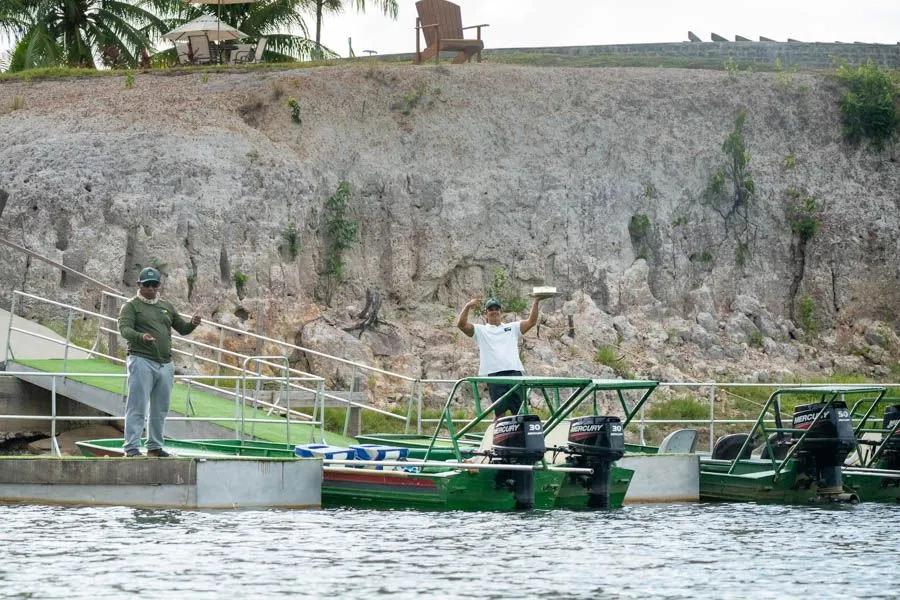


The guides at Agua Boa are all native to this part of the Amazon, and when you ask them where they live, they usually will tell you the name of their town and how many hours away it is by boat. Most of the guides are many hours away from their homes. The guides speak Portuguese and other native dialects from the region. They do all speak some English, but are generally most comfortable with their "fishing English". They use 9 o’clock through 3 o’clock, relative to the bow of the boat at 12 o'clock, to help guide your casting direction, and they will instruct you to strip fast or slow depending on the species or situation. Their boats are long, relatively shallow, aluminum river skiffs with outboard motors to get up and down the river. During lower water years they will switch to jet outboards so they can glide over the shallow sand bars. Each boat also has a poling platform, which is the guides' primary technique for moving clients around while fishing. If you’ve ever been saltwater fishing where your guide was poling the flats, it is a very similar experience.


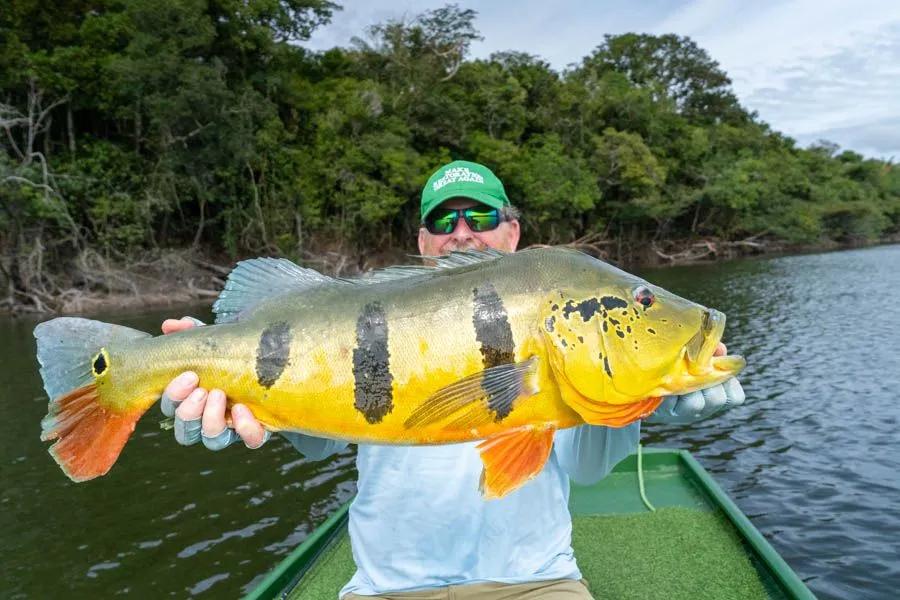
For the most part this is a streamer fishery, with some mixed opportunities to throw some surface patterns, such as Gurglers, Bangers, etc. Most of us fished with 9-weight rods, and we spent the majority of the time casting clear tip intermediate lines. A heavier sinking line with a dark tip also came in handy on a few of the days when we fished some deeper water. We did use a floating line for some surface fishing, but if you had to pick just two lines for this fishery, an intermediate clear tip and a heavier sinking line with a dark tip would be best in my experience. Most of the surface flies used here are buoyant enough that you could fish them with an intermediate line if needed. Although you could take a variety of rod weights for different situations, I think the 9-weight is probably the Goldilocks of this fishery. It allows you to fish big flies in a variety of conditions all day long without getting overly exhausted, and it's big enough to handle most of the larger fish you will encounter, with the exception of some of the larger arapaima. From my experience you usually don’t have time to switch rods when you see an arapaima, so you either must feel comfortable with what you are already casting, or simply decide that you are under gunned for the situation. Some arapaima are landed at Agua Boa each season, but it is hard to plan for the moment when you might have a shot at one. Arapaima are the largest scaled freshwater fish in the world and some over 200lbs can be seen rolling in the river at times...they are true river monsters!!!

One day, we poled up to a major disturbance on the surface of the water and realized that a bunch of spotted bass were zealously attacking a school of baitfish, and were so focused that they were oblivious to our presence. We had dry fly rods rigged with floating Gurgler patterns, and Clark quickly grabbed one and cast to the ball of fish. In no time he was hooked up on a nice bass. This was one of the rare occasions where I also felt the urge to also get a line out there while Clark was playing his fish, and I quickly had another bass smash my Gurgler. Although we fished more streamers than surface patterns, the explosive takes on top water patterns were some of my most cherished memories from the trip.
Peacock bass and most of the targeted species in the Agua Boa Amazon Lodge are predators, so streamer fishing is the name of the game. The preferred streamer style for most of the fishing is tied on a 3/0 hook and is about 5” in length. A variety of patterns are used, but the primary fly we used in our boat was some sort of variation of the Flashfire Mushy in chartreuse and white, gray and white, and olive and white. Dozens of different patterns and color variations were used throughout the week, and each guide and situation was different. We also hooked and landed some of our biggest peacocks of the week on some crazy 12" long black/blue/purple flies, and others with bright colors like hot pink and red. By far the most productive color pattern throughout the week was chartreuse or olive green with white, but having a variety of colors and sizes did come in handy. I would recommend changing out flies regularly if you are finding the fishing to be slow - on multiple occasions this trip a change in color and/or pattern seemed to quickly improve our success. Another noteworthy pattern for the week was Cowen’s Baitfish, which is a bit on the smaller side, tied on a 1/0 hook, but it was very effective at times.
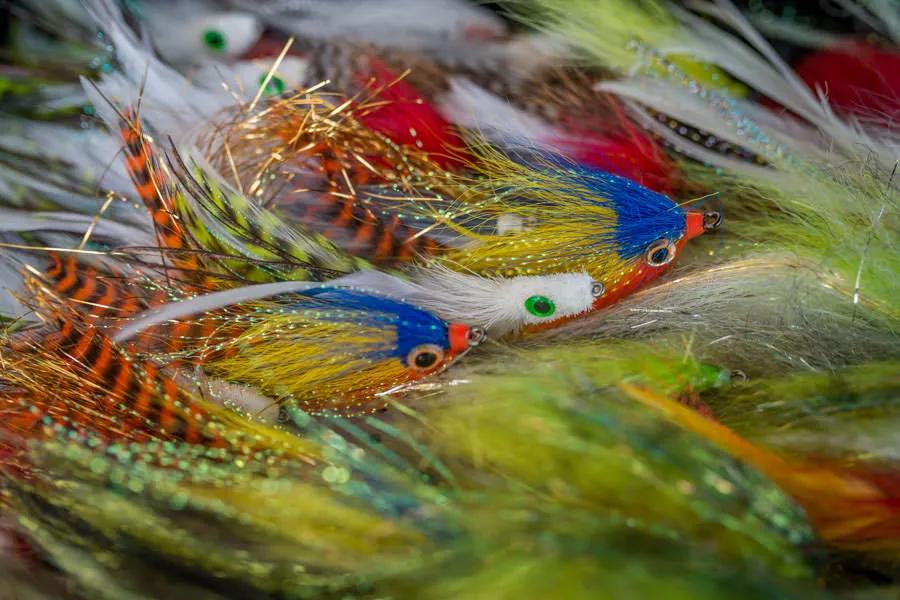


The most common tippet size that the guides wanted to use for the Peacocks was 50lb. Some of the guides like 60lb, especially if they thought you had a good chance of running into arapaima, and other guides were okay with 40lb. If I had to do it over again, I probably would have just showed up with a spool of 50lb and called it good, but I also like to have options just in case. They don’t use tapered leaders for this fishery, simply a long length of tippet, usually 6ft or more. I found that our catch rates went down when our "leaders" got too short. Peacock bass and other fish in the Amazon are hard on flies and line, so I recommend inspecting your fly and tippet after every fish to make sure it is not damaged. If so, cut off the damaged section or change flies and retie. You don’t want to lose the fish of a lifetime because you forgot to inspect your tippet and didn't realize it was damaged. Another tool that I found handy was a brush to comb out my flies throughout the day. Most of these streamers are tied with long fibers that get matted and tangled with each fish, but you could extend their lives with a nice stiff toothbrush or dubbing brush.
Although peacock bass are the soup du jour for most anglers, if you wanted to take some time after the main part of your fishing day to bump up your numbers you could target some of the hundreds of smaller fish that hang out near the boat dock at the lodge, namely the pacu. These fish are a relative of the piranha, but feed more similarly to trout. They are most well known for their appetite for jungle nuts that fall in the water, but they also feed on small bugs, especially in the evenings. They are capable of biting off your fingers and cutting through light tippets, so beware and choose your equipment wisely. If you are the type that likes to catch as many fish as possible or just wants to experience as much of the area and lodge as possible, I recommend packing a smaller rod like a 6 weight and tying on some smaller, classic dry fly patterns to go after these fun fish. Head out to the dock after dinner and you will likely see dozens of them rising to the surface. Not being familiar with hatches in the Amazon I don’t have any specific fly recommendations, but I witnessed some midges hatching, and my gut tells me the pacu would eagerly take an ant as well. I’m guessing a Parachute Adams or Elk Hair Caddis in size 14-16 would also do the trick. You’ll also want to keep your eyes peeled for Rex, the resident cayman. I’m a big guy, but I know I wouldn’t win that fight.

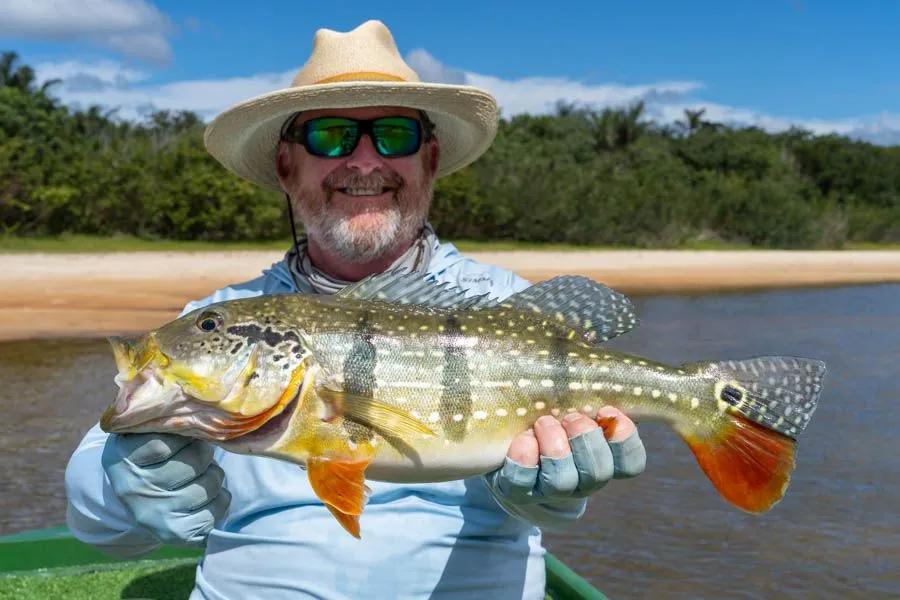

This place is Valhalla for streamer fisherman. You have predators all around that are hungry, and you can often hear thrashing along the shallows of the river or banks of the lakes where peacock bass are chasing prey. Peacock bass are aggressive, often jump out of the water while you are fighting them, and are simply gorgeous fish to top it all off. I’m often impressed by an especially beautiful trout, but every single peacock bass that we landed was like a treasure, whether it was a smaller butterfly, a medium sized speckled peacock, aka paca, or a big temensis.
Every guide has their own style of fishing and guiding. Some of the guides wanted you to cast constantly all day and they usually kept you a specific distance from the bank to do so, while others wanted you to stand at the ready until a fish worth casting to was in sight. It is helpful in those cases if you are also looking for fish along with guide, as you will sometimes be able to spot fish they don't see, but most of the time the guide is asking you to cast to a fish they spotted but that you can’t see. Spotting fish is another skill that can only be learned with hours and hours on the water. High quality polarized sunglasses with the appropriate lens color for the light conditions are extremely valuable for this type of fishing. Not all the fishing takes place in the river, in some cases you might hike a short distance to a lagoon hidden in the jungle where they have other boats stashed away.
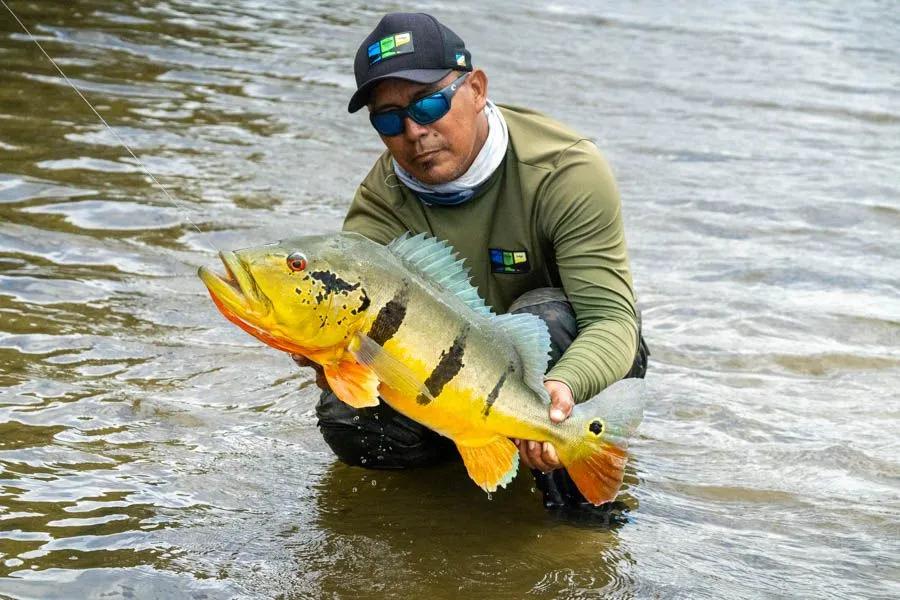
The guides at Agua Boa can be a bit quiet, but I learned that if you asked them for some guidance, especially when they weren’t on the poling platform they are very willing to teach. I highly recommend that all anglers who go to Agua Boa Lodge pull each of their guides aside first thing in the morning and ask them to teach you how they want you to strip and set the hook. If you want any help with casting, they will be able to give you advice as well. Of course, some of the guides are better than others at teaching and communicating, as is true anywhere.
If you are considering a trip to Agua Boa Lodge or are already signed up, I highly recommend you practice casting with the rod and line you intend to fish with, or a comparably heavy rod. The fishing isn't overly technical and you pick it up very fast, but it is nice to have had a little practice time casting with an 8 or 9 weight at home before making the trip in order to expedite the learning curve once you are in the jungle. It will improve your overall experience and will make you a more productive angler. If you can cast a heavier rod with a sinking line accurately at 60’ you will increase your success rate. If you are mostly a trout angler and are used to setting the fly by lifting your rod, I also recommend finding a way to practice strip setting, and aggressively strip setting at that. These are big fish and big hooks, so you need to apply a significant amount of pressure to successfully set the hook. I burned my fingers a couple of times when I finally figured out how to set on these fish correctly. The hook set is very similar to salt water fishing, except you get a lot more opportunities in the Amazon! After the week, I left a much better angler in terms of building the muscle memory to strip set and continue setting the hook after the first grab.
Another overlooked facet of an Amazon trip is hand care—it is very important. I recommend two pairs of high quality sungloves that go higher up on your fingers. A lot of my line control happens at the first knuckle of my index finger. If you don’t have sungloves that cover that spot I would recommend either stripping guards or Nexcare Waterproof Tape. I tried vet wrap, which was easy to apply and relatively inexpensive, but it didn’t hold up very well throughout the day. It is likely that you will get some cuts on your hands, so I also recommend waterproof bandages and an antibiotic ointment. You should be prepared to land all your fish, so your guide doesn’t have to get down from the poling platform to assist you. You don’t want to lip the peacock bass as they have sandpaper-like teeth that will eventually abrade your fingers and may make them bleed. I recommend a Boga Grip to handle fish that also has a large foam float attached in case you drop it. The bogas can come in handy when you are holding the fish in the water while removing the fly. Once the fly is removed they are pretty easy to handle for a quick photo without a boga. You also want a good pair of pliers or hemostats to help you remove hooks from the fish and de-barb hooks. I had a few fish swallow the streamer deep, so pliers that are at least 6” long are recommended. Also, the barbs of these heavy hooks can be tough to depart with standard trout hemostats, so make sure your pliers can handle that pressure, or de-barb your hooks in advance.
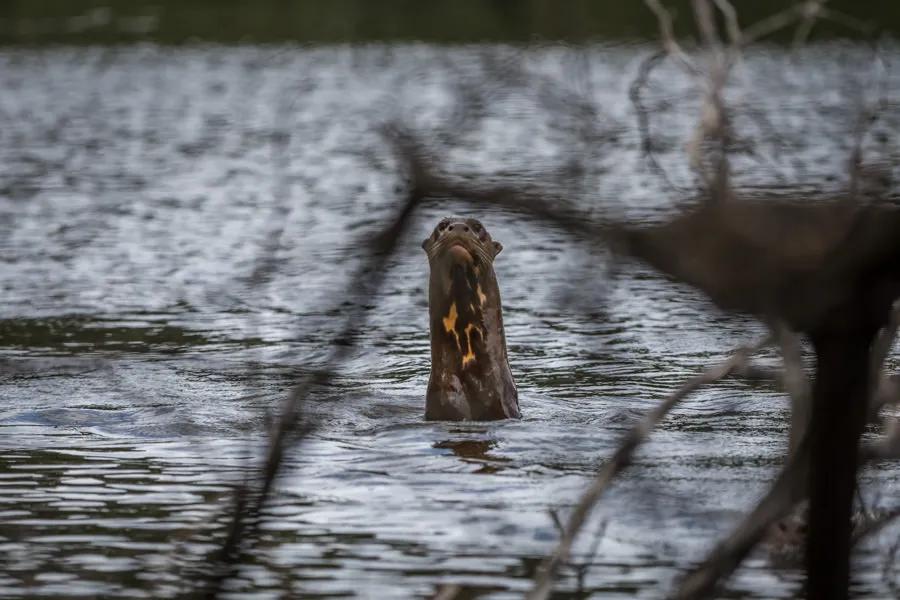
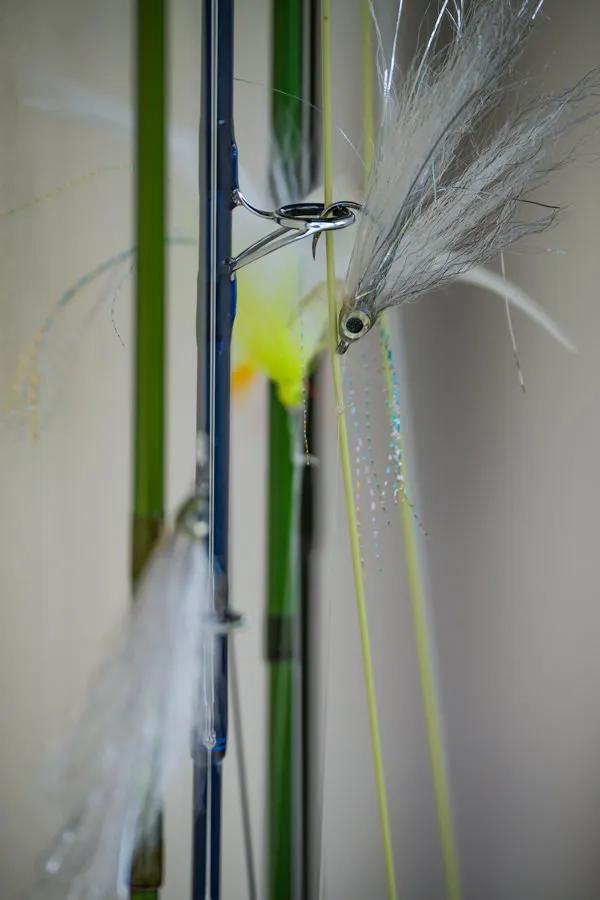

This place is hot, close to the equator, and you need to dress to protect yourself from the sun and hydrate diligently. To protect myself from the sun I wore a hooded sun shirt, neck gator, long quick dry pants, and footwear that was breathable but didn’t allow sun to penetrate. Footwear is more important than you’d think as you need to protect your feet from the sun, be able to jump out of the boat, hike through the jungle, and manage your fly line at your feet all day. I opted for a flat-bottomed boat shoe with nothing to hang up on, such as laces. Some people opted for socks in the boat, which work well in light colors that don't absorb the sun. The challenge with socks is the casting deck gets hot and they don’t insulate you from feeling it. Although I prefer wide brim hats for the added sun protection, they don’t work especially well with hoods on sun shirts. Again, high quality polarized sunglasses are very helpful for spotting fish. The guides seemed to prefer an amber colored lens in general, but if you happen to have a lighter lens for low light situations, I would also recommend having those available for cloudy conditions or for later in the day. You’ll want a good pair of nippers unless you have a pair of pliers with scissors built in.
You’ll obviously want to have a high-quality sunscreen for the skin that is exposed to the sun and apply more than once throughout the day, especially if it rains. Rain gear came in handy throughout the trip, as did some sort of waterproof bag for fishing gear and electronics. I used a waterproof fishing sling that worked well for my flies, phone, and rain jacket. Depending on the size of your camera you may need something more substantial to store it safely. A waterproof backpack also works well if you like to carry a bit more gear and can double as a carry on. If you are debating whether to bring your nice camera, you shouldn’t hesitate. You’ll want to be able to document the fish you catch, the wildlife you encounter and the people you meet. Most phones take some amazing photos, but if you own a great telephoto lens, you will be kicking yourself if you leave it behind.
To get to Agua Boa Amazon Lodge we all flew into Manaus. Most of us stayed at least one night in Manaus, and a handful participated in a city tour, which was a great way to get acclimated to the climate, do some walking and experience some of the Amazonian history and culture. Without a doubt the favorite stop for everyone was the fish farm, where we were able to feed and temporarily play arapaima with the help of makeshift rods that had baitfish tied on to the end of a strong twine. Arapaima are one of the biggest scaled fish in the world and are shockingly fast and powerful. We also got to view the Meeting of the Waters, where the Amazon River and the Rio Negro meet, a few miles away from Manaus. The water of the Rio Negro appears black in color, while the Amazon is a golden-brown color from sediment. The two different colors don’t mix for several miles downstream due to differences in temperature, density and water speed. The fish market is also a spectacle to see, with hundreds of people selling all sorts of fish, meat, and vegetables from the open stalls. Our group all stayed at the Villa Amazonia Hotel, which had lovely staff and a good restaurant. We also had dinner one night at Opera Restaurante, another great location just a short walk from the hotel. Many of our guests opted to Uber around the town in search of other food options, places to buy nice wine and spirits, and to look for some cigars for their stay at the lodge. The lodge does include wine and beer, but some folks opt to bring their own.


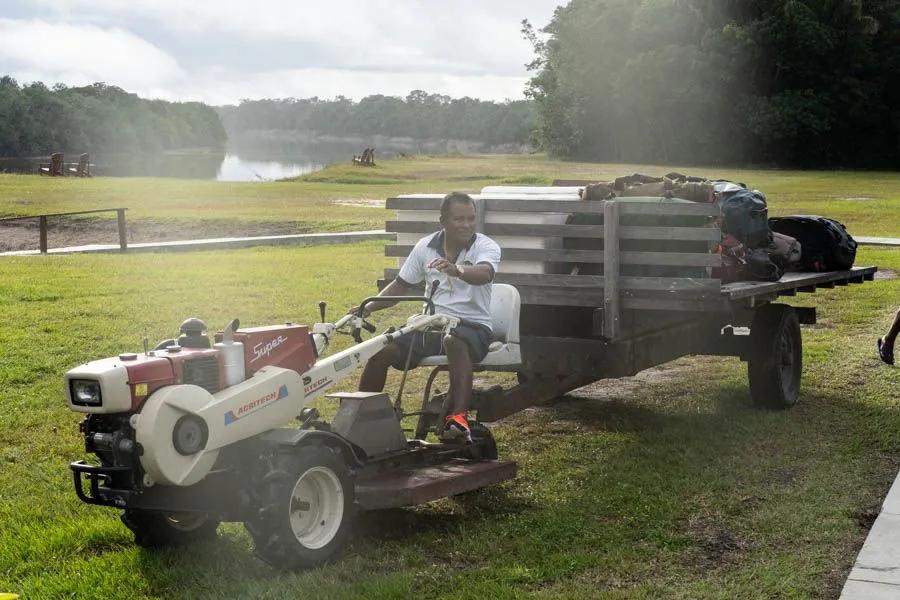
This is an amazing fishing location that I highly recommend to anyone that loves streamer fishing and wants to experience an unique part of the Amazon that very few people ever get to see. Home in Montana, I find myself sometimes being overly critical of folks that are pulled over on the side of the road to look at deer or elk nearby, but now I understand. To the guides, these are animals they see and hear every day, but for someone who has spent nearly their entire life in the Rocky Mountains everything was unique and new. I grew up seeing commercials with Toucan Sam on Fruit Loops commercials, but now I can say that I spent an hour listening to and photographing toucans in the Amazon. I also saw pics from guests that stayed at the lodge a week or two after us who were able to photograph a Jaguar feeding on a cayman on the river bank. Even though I wasn’t there to see that clash of predators in person, because I now feel connected to this place I feel like I also experienced it and it makes me want to go back.
I feel very fortunate to have had the opportunity to see such a wonderful place, catch some magnificent fish, enjoy the company of many great people, and experience Amazonian wildlife. Thank you to all the guests that made this trip possible and all of the staff at Agua Boa Amazon Lodge and support crew in Manaus. This one will be hard to beat!
